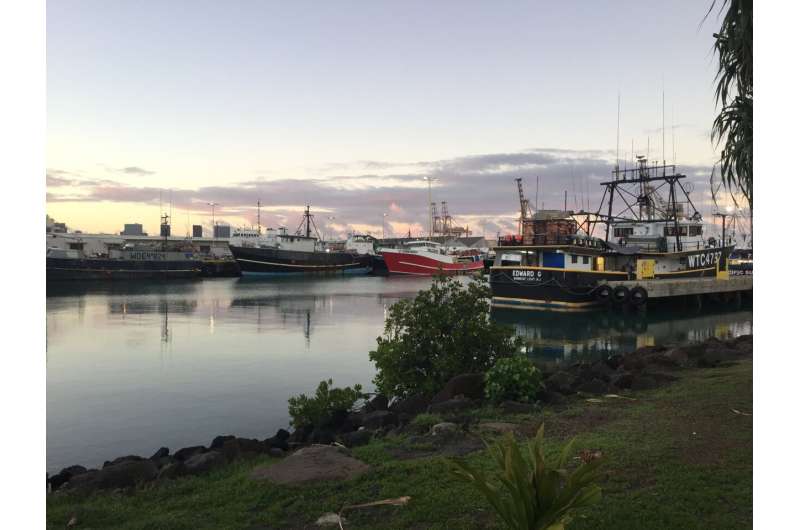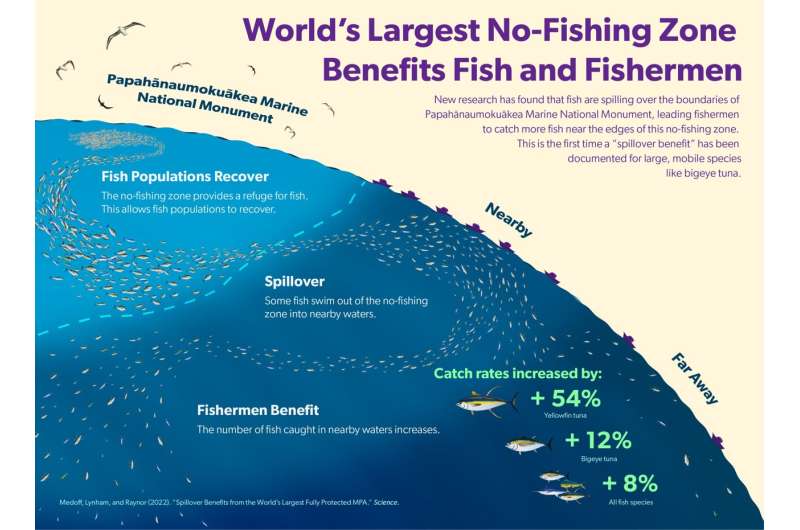World's largest no-fishing zone benefits fish and fishermen

A study published in the journal Science shows for the first time that carefully placed no-fishing zones can help to restore tunas and other large, iconic fish species. It is well known that no-fishing zones can benefit sedentary marine life, like corals or lobster; but until now, it was assumed that no marine protected area (MPA) could be big enough to protect species that travel long distances, such as tunas. This recovery is good news not only for the environment, but also for the global tuna fishing industry, which generates $40 billion in revenues each year and supports millions of jobs across the world.
"We show for the first time that a no-fishing zone can lead to the recovery and spillover of a migratory species like bigeye tuna," said co-author John Lynham, a professor in the Department of Economics at the University of Hawaiʻi at Mānoa's College of Social Sciences.
Using data collected onboard fishing boats by scientific observers, the study found that the world's largest no-fishing zone, Papahānaumokuākea Marine National Monument, has increased the catch rate of yellowfin tuna by 54% in nearby waters; catch rates for bigeye tuna increased by 12%; catch rates for all fish species combined increased by 8%.
The size of this no-fishing zone—almost four times the size of all the land in California—and the apparent homing behavior of some tuna species in the region likely played a role in the positive effects observed.
Co-author Jennifer Raynor, a professor in the Department of Forest and Wildlife Ecology at the University of Wisconsin-Madison, said, "Over the past 30 years, we have learned that tunas do not venture as far away from home as we once thought. The Hawaiian Islands are a nursery for baby yellowfin tuna, and it turns out that many of these fish stay in the region."

Aside from their economic significance, yellowfin tuna and bigeye tuna (also known as ʻahi) have long held a central place in Hawaiʻi's culture and diet.
Co-author Sarah Medoff, a researcher at the School of Ocean and Earth Science and Technology at the University of Hawaiʻi at Mānoa, said, "Being born and raised in Hawaiʻi, I know how important ʻahi is to the community here. It's not just something eaten in fancy sushi restaurants, it's the focal point of family gatherings, weddings, birthdays, graduation ceremonies and New Year's Eve parties. It's reassuring to know that the monument is protecting this resource for my own children and for future generations."
Papahānaumokuākea was created in 2006 and expanded in 2016 to protect biological and cultural resources, not specifically to generate benefits to the local tuna fishery. The area is considered sacred by Native Hawaiians and the monument is co-managed by Native Hawaiians, the state of Hawaiʻi and the federal government.
According to Kekuewa Kikiloi, an associate professor in the Kamakakūokalani Center for Hawaiian Studies at the University of Hawaiʻi at Mānoa, who was not involved in the study, "This research by Medoff et al. reaffirms the value of large scale marine protected areas in the Pacific. The protections that were fought for by Native Hawaiians and other stakeholders for Papahānaumokuākea serve to benefit everyone, including fishing interests."
More information: John Lynham, Spillover Benefits from the World's Largest Fully Protected MPA, Science (2022). DOI: 10.1126/science.abn0098. www.science.org/doi/10.1126/science.abn0098
Journal information: Science
Provided by University of Hawaii at Manoa



















